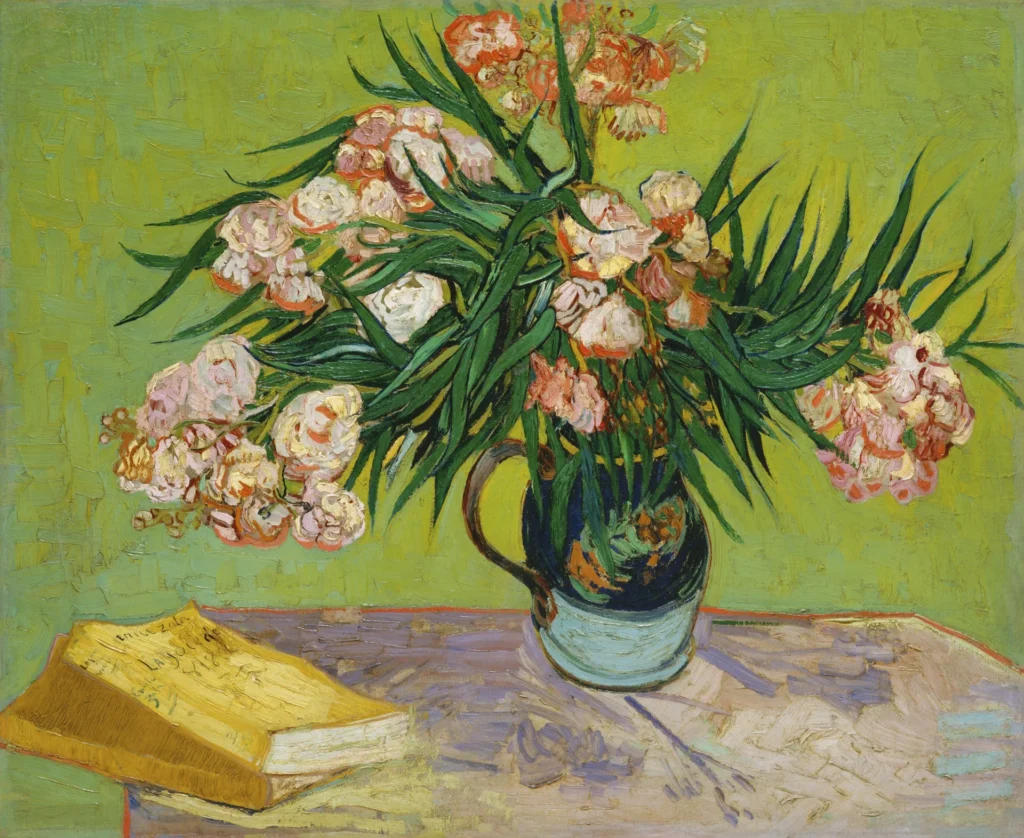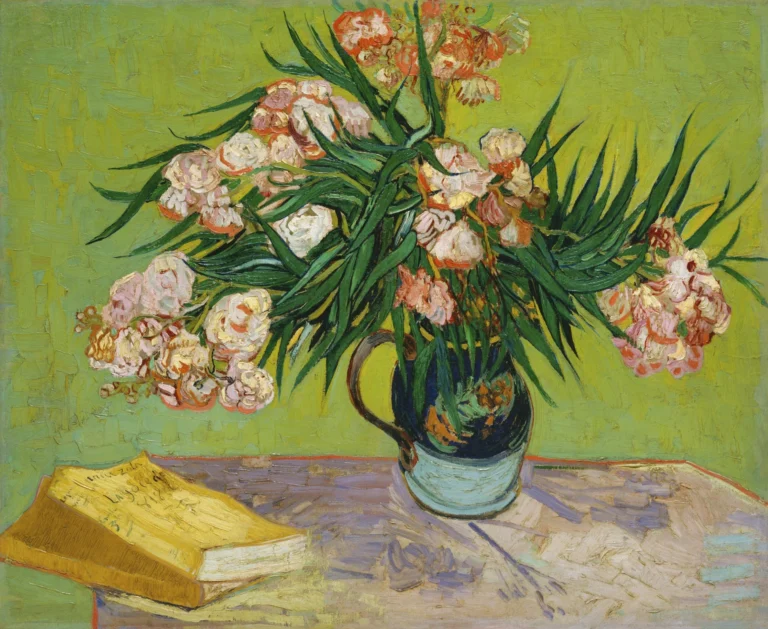Oleanders (1888)
Created in August 1888, Oleanders is a still life by Vincent van Gogh that features a majolica jug brimming with oleander flowers alongside Émile Zola's novel, 'La Joie de Vivre.' This work captures Van Gogh's signature style through bold colors and sweeping brush strokes, contrasting the fragile beauty of the flowers with the stability of the book. Symbolizing joy and life, the painting explores the artist's emotional connection to nature and literature. With its vibrant palette and innovative techniques, it reflects Van Gogh's mastery and emotional depth during his Arles period.
August 1888
About the Artwork
Vincent van Gogh painted 'Oleanders' during a prolific moment in his career while he was living in Arles in 1888. The painting features a vibrant display of oleander flowers, which Van Gogh frequently used in his still lifes as symbols of vigor and life. By placing Émile Zola’s novel 'La Joie de Vivre' alongside the flowers, he creates a narrative that intertwines literature with the beauty of nature. This juxtaposition serves not only as a personal tribute to the joys of life but also an exploration of artistic stimulation that Zola's work provided. Van Gogh's distinctive technique, characterized by thick application of paint and swirling patterns, allows the artwork to embody both enthusiasm and movement, encapsulating a sense of joyous abandon that is quintessentially his own. The painting's current home at the Metropolitan Museum of Art highlights its enduring significance in the art world.
Did You Know
In Van Gogh’s work, oleanders represent more than mere flowers; they symbolize vitality and an inexhaustible spirit of life, reflective of the artist’s internal emotions and philosophical beliefs during his time in Arles.
The inclusion of Émile Zola’s ‘La Joie de Vivre’ alongside the flowers highlights Van Gogh’s appreciation for literature. Zola’s exploration of life’s joys resonated with Van Gogh, emphasizing the interconnectedness of art, literature, and nature.
Van Gogh’s bold use of color and dynamic brush strokes in ‘Oleanders’ foreshadowed the developments in cubism. His innovative approach to form and color paved the way for future artists who experimented with abstraction and composition.
Liked what you see? Add it to your collection.
Enjoyed reading? Share it.
... continued
Composition and Elements
- The painting features a majolica jug filled with oleander flowers, which Van Gogh often used in his still lifes made in Arles.
- Alongside the jug, Van Gogh placed a copy of Émile Zola's novel "La Joie de Vivre" (The Joy of Living), symbolically juxtaposing it with the vibrant flowers.
Artistic Style and Technique
- The oleanders are painted with a "virile touch" using circling strokes and thick parallel dabs, contrasting sharply with the spiky, entangled green leaves outlined in black.
- The painting is characterized by its rich variation and interweaving of tones, retaining the vibrancy and freedom seen in Van Gogh's landscapes.
Symbolism and Meaning
- For Van Gogh, oleanders were symbolic of joy and life-affirmation, as they bloomed "inexhaustibly" and constantly produced new shoots.
- The placement of Zola's novel emphasizes Van Gogh's love for flowers and their symbolic representation of life and vitality.
Artistic Choices
- The painting features bold artistic choices, such as the lilac shadow and the red accents along the edge of the table.
- The drawing of the books and the table shows an audacious and joyful abandon in color and brush strokes, foreshadowing elements of late cubist designs.
Current Location
"Oleanders" is part of the collection at the Metropolitan Museum of Art, having been gifted by Mr. and Mrs. John L. Loeb in 1962.










